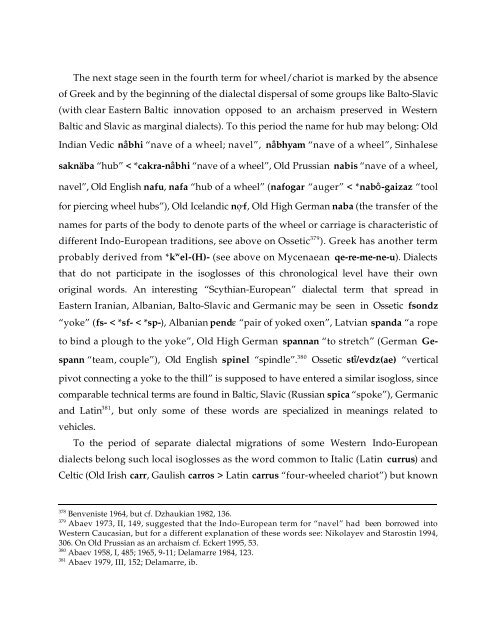Comparative Notes on Hurro-Urartian, Northern Caucasian
Comparative Notes on Hurro-Urartian, Northern Caucasian
Comparative Notes on Hurro-Urartian, Northern Caucasian
You also want an ePaper? Increase the reach of your titles
YUMPU automatically turns print PDFs into web optimized ePapers that Google loves.
The next stage seen in the fourth term for wheel/chariot is marked by the absence<br />
of Greek and by the beginning of the dialectal dispersal of some groups like Balto-Slavic<br />
(with clear Eastern Baltic innovati<strong>on</strong> opposed to an archaism preserved in Western<br />
Baltic and Slavic as marginal dialects). To this period the name for hub may bel<strong>on</strong>g: Old<br />
Indian Vedic nâbhi “nave of a wheel; navel”, nâbhyam “nave of a wheel”, Sinhalese<br />
saknäba “hub” < *cakra-nâbhi “nave of a wheel”, Old Prussian nabis “nave of a wheel,<br />
navel”, Old English nafu, nafa “hub of a wheel” (nafogar “auger” < *nabô-gaizaz “tool<br />
for piercing wheel hubs”), Old Icelandic no1’f, Old High German naba (the transfer of the<br />
names for parts of the body to denote parts of the wheel or carriage is characteristic of<br />
different Indo-European traditi<strong>on</strong>s, see above <strong>on</strong> Ossetic 379 ). Greek has another term<br />
probably derived from *k w el-(H)- (see above <strong>on</strong> Mycenaean qe-re-me-ne-u). Dialects<br />
that do not participate in the isoglosses of this chr<strong>on</strong>ological level have their own<br />
original words. An interesting “Scythian-European” dialectal term that spread in<br />
Eastern Iranian, Albanian, Balto-Slavic and Germanic may be seen in Ossetic fs<strong>on</strong>dz<br />
“yoke” (fs- < *sf- < *sp-), Albanian pendE “pair of yoked oxen”, Latvian spanda “a rope<br />
to bind a plough to the yoke”, Old High German spannan “to stretch” (German Ge-<br />
spann “team, couple”), Old English spinel “spindle”. 380 Ossetic stî/evdz(ae) “vertical<br />
pivot c<strong>on</strong>necting a yoke to the thill” is supposed to have entered a similar isogloss, since<br />
comparable technical terms are found in Baltic, Slavic (Russian spica “spoke”), Germanic<br />
and Latin 381 , but <strong>on</strong>ly some of these words are specialized in meanings related to<br />
vehicles.<br />
To the period of separate dialectal migrati<strong>on</strong>s of some Western Indo-European<br />
dialects bel<strong>on</strong>g such local isoglosses as the word comm<strong>on</strong> to Italic (Latin currus) and<br />
Celtic (Old Irish carr, Gaulish carros > Latin carrus “four-wheeled chariot”) but known<br />
378 Benveniste 1964, but cf. Dzhaukian 1982, 136.<br />
379 Abaev 1973, II, 149, suggested that the Indo-European term for “navel” had been borrowed into<br />
Western <strong>Caucasian</strong>, but for a different explanati<strong>on</strong> of these words see: Nikolayev and Starostin 1994,<br />
306. On Old Prussian as an archaism cf. Eckert 1995, 53.<br />
380 Abaev 1958, I, 485; 1965, 9-11; Delamarre 1984, 123.<br />
381 Abaev 1979, III, 152; Delamarre, ib.





